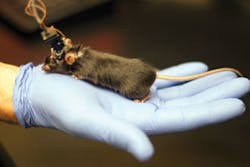Miniature fluorescence microscopy platform for imaging neural circuits launches commercially
Inscopix (Palo Alto, CA) has brought its nVista brain imaging platform—which can view upwards of 1000 neurons simultaneously in one field of view—to market. Originally only accessible through the Neuroscience Early Access Program (NEAP), Inscopix plans to expand the system's reach to the widest spectrum of neuroscience investigators through packages customized for specific researcher needs.
Centered on a patented miniature microscope technology from Stanford University (California), the nVista system can decode the neural language underlying brain function and behavior. With the microscope, a tiny fluorescence camera can be implanted in hard-to-reach areas of a freely moving animal's brain and record millisecond-by-millisecond movies of the activity of large neural networks over days or several months. The technology development at Stanford University was made possible through a $1 million grant from President Obama's BRAIN Initiative in 2014.
Since the launch of NEAP in 2012, Inscopix disseminated nVista to over 100 early-adopter labs that played a crucial role in maturing the platform through feedback and scientific validation for its incorporation into standard neuroscience practice. NEAP researchers have published close to 20 research articles with the system in journals such as Neuron, Nature, and Cell, that provided deeper insights into multiple aspects of brain function, including motivation, learning and memory, and goal-directed behaviors. nVista also led to Inscopix's recognition by the World Economic Forum as a "Technology Pioneer" in 2015.
For more information, please visit www.inscopix.com.

